Content Menu
● The Importance of Bright Swimwear
>> Why Bright Colors Are Better
>> Best Colors for Visibility
● Beach Safety Tips
>> Know the Beach Rules
>> Stay Sun Safe
● The Science of Color Visibility in Water
● Research Findings on Swimsuit Color Visibility
● The Most Visible Colors for Kids' Swimsuits
● Colors to Avoid
● The Importance of Contrast
● Factors Affecting Visibility
● Additional Safety Considerations
● Practical Tips for Parents and Caregivers
● The Role of the Aquatics Industry
● Pool Safety Guidelines
>> No Running Near the Pool
>> Learn to Swim
>> Use Floatation Devices
● Conclusion
When it comes to ensuring the safety of children in and around water, every detail matters. One aspect that often goes overlooked but can play a crucial role in water safety is the color of a child's swimsuit. Recent studies and expert opinions have shed light on how the choice of swimwear color can significantly impact visibility in various aquatic environments, potentially making a life-saving difference in emergency situations. This article delves into the importance of swimsuit color for kids' water safety, exploring the science behind color visibility in water, expert recommendations, and practical tips for parents and caregivers.
The Importance of Bright Swimwear
When kids go swimming, wearing bright swimwear is super important. Bright colors help make sure they are easy to see in the water. This is really helpful when there are many people around, like at a busy beach or pool. With bright swimwear, parents and lifeguards can spot kids quickly, which helps keep them safe.
Why Bright Colors Are Better
Bright colors like yellow, pink, and orange stand out against the blue water. This is why swim visibility is so important. If a child wears a dark swimsuit, they can be hard to see. But when they wear bright swimwear, it’s much easier for everyone to keep an eye on them. This can help prevent accidents and ensure that kids are safe while having fun.
Best Colors for Visibility
Some colors are better than others for being seen in water. Colors like neon green, bright blue, and hot pink are great choices. In a swimming pool, these colors pop out against the blue water. At the beach, bright colors also stand out against the sand and waves. Choosing these colors can make swimming safer and more enjoyable for kids.
Beach Safety Tips
When kids are near the water, it’s super important to keep a close eye on them. Always supervise your children while they are swimming or playing at the beach. Even if they are wearing the best child swimwear, accidents can happen quickly. Being there means you can help if they need assistance or if they get too far away from the shore.
Know the Beach Rules
Every beach has its own safety rules. These rules might include things like swimming only in designated areas, listening to lifeguards, or staying away from certain parts of the beach. Encourage your kids to learn and follow these beach rules. This way, they can have fun while also being safe.
Stay Sun Safe
Sun safety is very important at the beach. The sun can be strong, and kids need protection to avoid sunburn. Make sure to apply sunscreen on all exposed skin and reapply it every two hours. Wearing a wide-brimmed hat can help shield their face and eyes. Also, consider using UV-protective clothing, which can keep them cooler and safer from the sun's rays while enjoying the water.
The Science of Color Visibility in Water
To understand why certain swimsuit colors are safer than others, it's essential to grasp the basics of how light behaves in water. Water absorbs different wavelengths of light at varying rates, which affects how colors appear when submerged. As light penetrates deeper into water, colors begin to fade and lose their vibrancy. This phenomenon is crucial when considering the visibility of a child wearing a swimsuit in a pool, lake, or ocean.
In general, water tends to absorb longer wavelengths of light first, such as reds and oranges, while shorter wavelengths like blues and greens penetrate deeper. This is why objects appear bluer or greener the deeper they are in water. However, the type of water (clear pool water, murky lake water, or saltwater) can also influence how colors are perceived underwater.
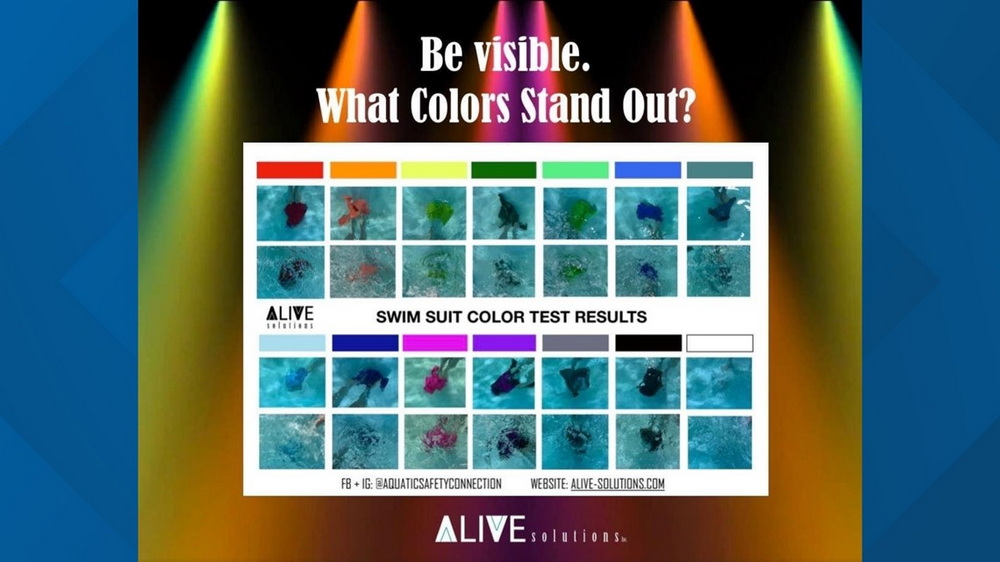
Research Findings on Swimsuit Color Visibility
Several studies have been conducted to determine which swimsuit colors offer the best visibility in different water conditions. These studies typically involve submerging various colored swimsuits in different types of water and assessing their visibility from above and below the surface. The results have been eye-opening and have led to important recommendations for water safety.
One notable study tested over a dozen swimsuit colors in both pool and open water settings. The researchers examined how visible each color was at different depths and under various lighting conditions. The findings consistently showed that certain colors stood out more than others, regardless of the water type or depth.
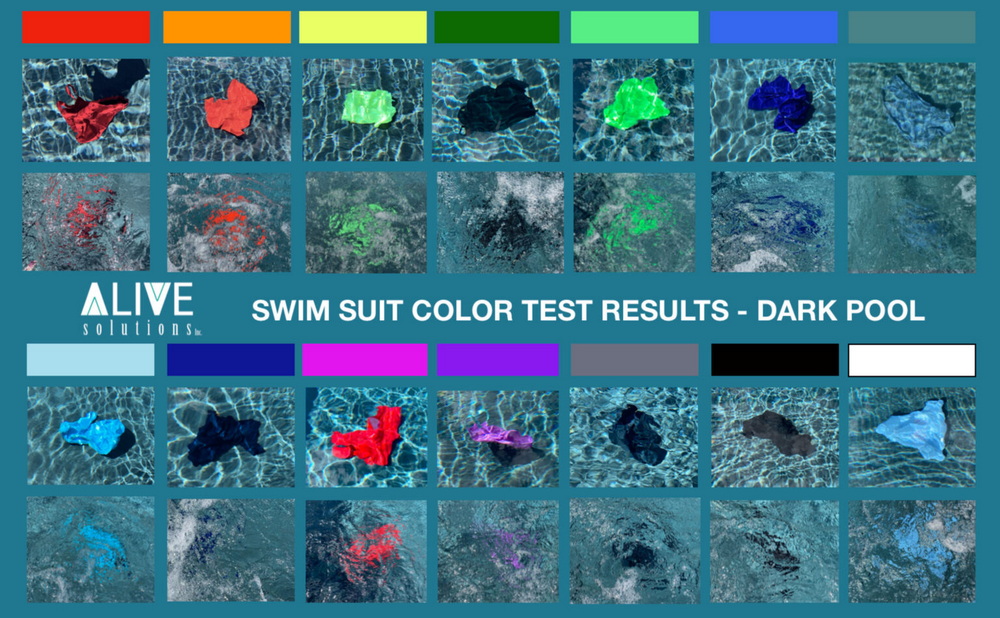
The Most Visible Colors for Kids' Swimsuits
Based on extensive research and expert analysis, certain colors have emerged as the safest and most visible options for children's swimwear. These colors consistently perform well in visibility tests across different water environments:
1. Neon Colors: Fluorescent or neon shades have proven to be the most visible in water. Neon pink, neon orange, and neon green are particularly effective in catching the eye, both above and below the water surface. These bright, unnatural colors contrast sharply with the typical blue or green hues of water, making them stand out even in murky conditions.
2. Bright Yellow: A vibrant, sunny yellow is another excellent choice for swimwear. It maintains good visibility in various water types and is easily spotted from a distance.
3. Bright Orange: Similar to yellow, bright orange offers high visibility in water. It's a color commonly used in safety equipment for a reason – it catches the eye quickly and effectively.
4. White: While not as immediately noticeable as neon colors, white can be surprisingly visible in water, especially in darker or murkier conditions. It provides a stark contrast against the water's background.
5. Neon Blue: Although blue might seem counterintuitive given the color of most water bodies, a neon or fluorescent blue can actually stand out well, particularly in pool settings.
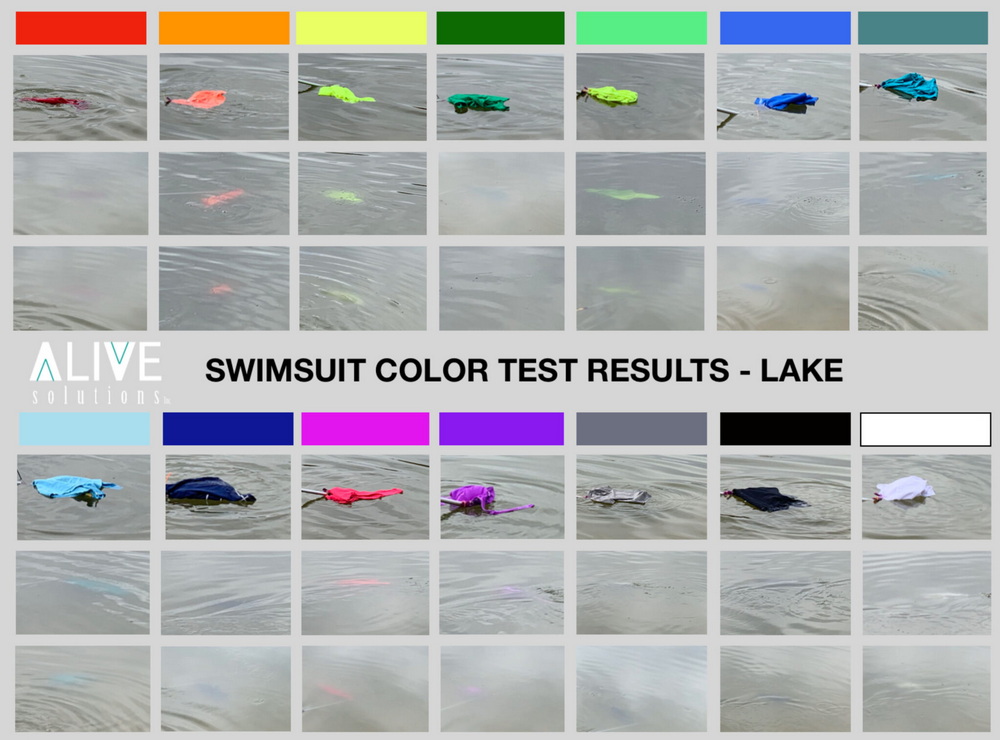
Colors to Avoid
Just as important as knowing which colors are most visible is understanding which ones to avoid. Some colors that may be popular or aesthetically pleasing can actually pose a safety risk due to their poor visibility in water:
1. Dark Blues and Navys: These colors tend to blend in with the water, making it difficult to spot a child quickly.
2. Black: Similar to dark blue, black swimsuits can be nearly invisible in water, especially in low-light conditions or at greater depths.
3. Earth Tones: Browns, dark greens, and other natural colors may look great on land but can camouflage a child in murky water or against a sandy bottom.
4. Pastel Colors: While pretty, pastel shades like light pink, baby blue, or mint green can quickly fade from view when submerged, particularly in deeper or less clear water.
The Importance of Contrast
While the specific color of a swimsuit is crucial, the concept of contrast is equally important. A swimsuit that contrasts sharply with the surrounding water and the child's skin tone will be more visible. This is why neon colors work so well – they provide a stark contrast against both the water and human skin.
For children with darker skin tones, bright yellows, oranges, and neon greens may offer the best contrast. For children with lighter skin tones, neon pinks and oranges can be particularly effective. The key is to choose a color that stands out against both the water and the child's complexion.
Factors Affecting Visibility
It's important to note that several factors can influence how visible a swimsuit color is in water:
1. Water Type: Clear pool water, murky lake water, and ocean water all affect color visibility differently. What works best in a pool might not be as effective in open water.
2. Depth: As mentioned earlier, colors change as they go deeper underwater. A color that's visible near the surface might become less noticeable at greater depths.
3. Lighting Conditions: Bright sunlight, overcast skies, or evening light can all impact how colors appear in water. The safest colors tend to perform well across various lighting scenarios.
4. Water Movement: Ripples, waves, and other water movements can affect visibility. Colors that maintain their distinctiveness even in moving water are ideal.
5. Distance: The ability to spot a child from a distance is crucial. Colors that remain visible from afar, both above and below the water surface, are preferable.
Additional Safety Considerations
While choosing the right swimsuit color is important, it should be part of a comprehensive approach to water safety. Here are some additional tips to enhance a child's safety in and around water:
1. Supervision: Constant adult supervision is the most critical factor in preventing water accidents. No swimsuit color can replace the vigilance of a responsible adult.
2. Swimming Lessons: Enrolling children in age-appropriate swimming lessons can significantly improve their water safety skills.
3. Life Jackets: For activities in open water or for non-swimmers, properly fitted life jackets are essential and should be worn at all times.
4. Water Safety Rules: Establish and enforce clear rules about water safety, such as no running near the pool, no diving in shallow areas, and always swimming with a buddy.
5. CPR Training: Adults supervising children around water should be trained in CPR and basic water rescue techniques.
6. Pool Safety Equipment: Ensure that proper safety equipment, such as reach tools and flotation devices, are readily available around home pools.
7. Barrier Protection: For home pools, implement multiple layers of protection, including fences, self-closing gates, and pool covers.
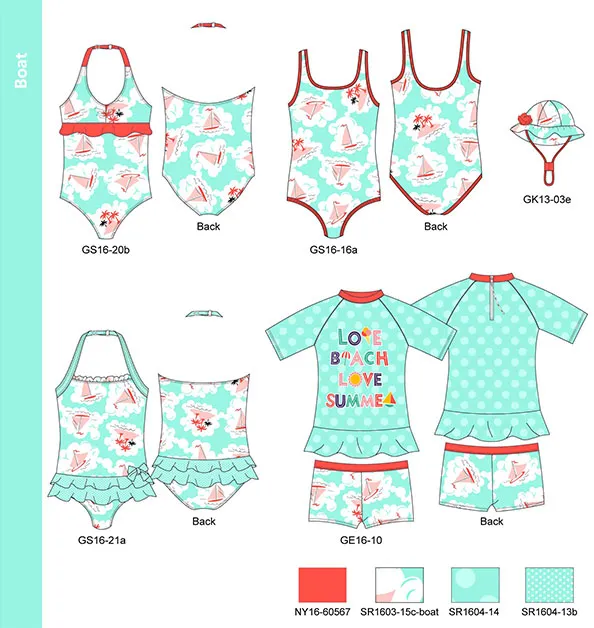
Practical Tips for Parents and Caregivers
When shopping for children's swimwear, keep these tips in mind:
1. Prioritize Safety Over Fashion: While many swimsuits come in cute designs and patterns, prioritize visibility and safety over style.
2. Consider Multiple Swimsuits: Have a variety of swimsuits in different highly visible colors for different water environments.
3. Test the Visibility: If possible, test the swimsuit's visibility in water before purchasing. Many stores with a focus on water safety may have displays or information about color visibility.
4. Combine with Bright Accessories: Pair the swimsuit with bright, visible accessories like swim caps, arm bands, or float suits for added visibility.
5. Replace Faded Swimwear: Over time, exposure to chlorine and sun can fade swimsuit colors. Replace swimwear when it starts to lose its vibrancy.
6. Educate Children: Teach children about the importance of being visible in water and involve them in choosing safe swimwear colors.
7. Consider UV Protection: While focusing on color, don't forget about sun protection. Look for swimwear with built-in UV protection for added safety.
The Role of the Aquatics Industry
The aquatics industry plays a crucial role in promoting water safety through swimwear design. Many manufacturers are now incorporating research findings into their product lines, offering a wider range of highly visible swimsuit options for children. Some companies are even developing new fabric technologies that enhance visibility in water.
Additionally, public pools, water parks, and beach safety organizations are increasingly aware of the importance of swimsuit color in safety. Some facilities have begun recommending or even requiring certain colors for children's swimwear during lessons or in high-risk areas.
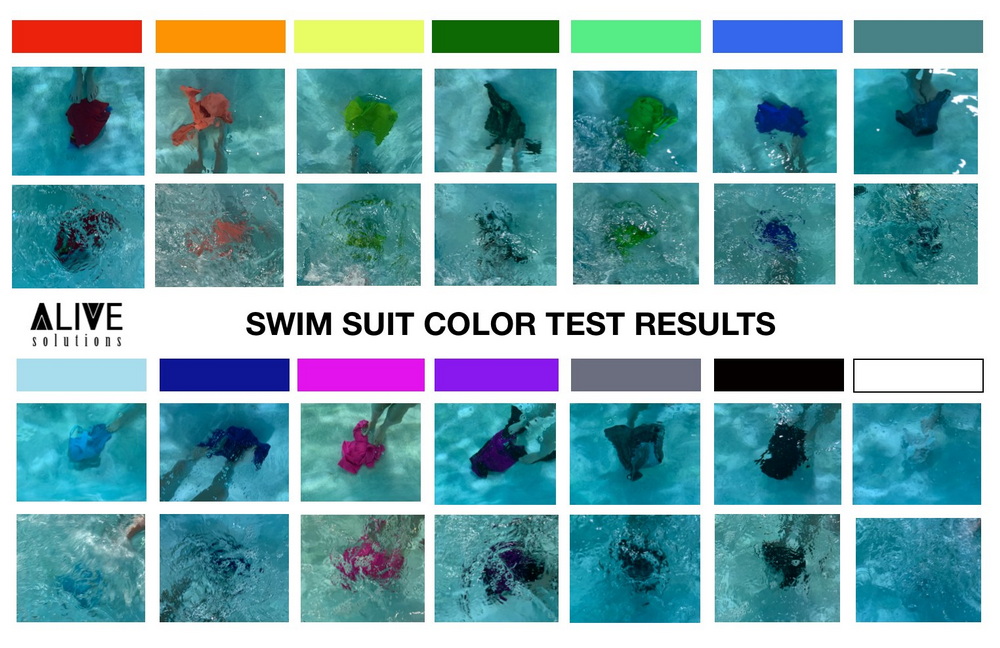
Pool Safety Guidelines
When kids are at the pool, it's important to follow some pool safety rules to keep everyone safe. The water can be fun, but it can also be dangerous if we don't pay attention. Here are some great tips to help ensure that kids have a good time while staying safe.
No Running Near the Pool
First things first: no running! The area around the pool can be very slippery. If kids run, they might slip and fall into the water or get hurt. It’s better to walk slowly and carefully near the pool. Remember, safety comes first!
Learn to Swim
Another important tip is to learn to swim. Taking swimming lessons can help kids become more confident and safer in the water. Knowing how to swim means they can enjoy themselves even more and be prepared for any unexpected splashes. Parents can look for local swim classes to help their children learn this important skill.
Use Floatation Devices
Using floatation devices is also a smart choice for kids who are still learning to swim. Floatation devices, like arm floats or life jackets, can help keep non-swimmers safe. However, it’s essential to choose the right type. Always use certified floatation devices and make sure they fit properly. Remember, even with floatation devices, kids should always be supervised by an adult when they are in or near the water.
By following these pool safety guidelines, children can enjoy their time at the pool while reducing the risks. Let’s make sure that swimming is a fun and safe activity for everyone!
Conclusion
The color of a child's swimsuit is more than just a matter of fashion or personal preference – it can be a crucial factor in water safety. By choosing highly visible colors like neons, bright yellows, and oranges, parents and caregivers can add an extra layer of protection for children in aquatic environments. However, it's important to remember that swimsuit color is just one aspect of water safety. It should be combined with proper supervision, swimming skills, and other safety measures to create a comprehensive approach to keeping children safe in and around water.
As research continues and awareness grows, we can expect to see more emphasis on swimsuit color as a safety feature. Parents, caregivers, and the aquatics industry all have a role to play in promoting this simple yet effective safety measure. By making informed choices about swimwear and prioritizing visibility, we can help ensure that every child's water experience is as safe as possible.
Ultimately, the goal is to create an environment where children can enjoy the water safely, building confidence and skills that will serve them well throughout their lives. While the right swimsuit color won't prevent all accidents, it can make a significant difference in those critical moments when every second counts. So the next time you're shopping for children's swimwear, remember: the brightest and most visible colors aren't just a fashion statement – they're a smart safety choice that could one day save a life.




































































